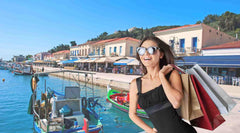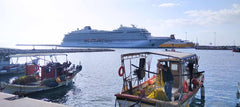Katakolon Greece, Cruise Port Facts And Things To Know

Katakolon is located in Peloponnese in Greece, so it is mainland and not an island as many guests believe.
Katakolon is pronounced "Ka-TA-ko-lon", with an accent in “TA”. Greeks call it Katakolo without an “N” but Katakolon is also correct.
Here are some interesting facts about Katakolon, a small and beautiful port in Greece:

-
Katakolon has a population of 509 citizens according to the last official Greek census of 2011.
-
Katakolon temperatures range from minimum 7.3(°C) or 45.1(°F) in January to maximum 31.6 (°C) or 88.9(°F) in August on average.
-
Katakolon has a long history. The area was described in writings of Thucydides, in "History of the Peloponnesian War" (Book II - chapter 25).
-
The Katakolon peninsula is crossed by faults that have caused earthquakes and tsunamis in the past. It is believed that such a natural disaster marked the end of the adjacent ancient town of Phea, the ancient and early medieval port town of Olympia.
-
The sunken city of Phea is mentioned by Homer, and some remains are still visible underwater in the cape of Katakolon (St. Andreas beach).
-
Katakolon is near Ancient Olympia (35 km / 21.8 miles), Skafidia village and Pyrgos city and is the main seagate to these places.

-
Although Katakolon is a small fishing village it is the second most important mainland cruise port in Greece (Piraeus being first) with an average of 290 cruise ship arrivals per year since 2006 carrying on average 592.000 passengers.
-
There are 97 businesses operating, statistically one business per family. Katakolon has a great market serving mainly locals and cruise ship passengers.
-
There is no hair salon or barber shop in Katakolon, you can find such services in the near town of Pyrgos.
-
2020 was a devastating year for the local economy because of the Covid crisis. There were only 10 cruise ship arrivals (a decline of 96% compared to the past annual average) with 7589 passengers (98% fewer visitors).

-
In Katakolon starts the longest beach in Greece, the gulf of Kyparissia. It is a sandy beach and locals call it “Europe's California”. It is approx. 44km (27.3miles) long and is part of the Natura 2000 network of nature protection areas in the territory of the European Union.
-
This beach is one of the main breeding places of the endangered loggerhead sea turtle (caretta caretta).
-
Katakolon has kept its unique “fishing village” character and has not been affected by massive tourism.
-
Katakolon has a volcano. It is actually a mud volcano: Mud volcanoes are not real volcanoes and are not as hazardous since they can only emit warm mud and only very locally (a few hundred meters around them). Mud volcanoes are generally encountered in areas where natural gas is present.
-
In the area, a small oil and gas field has been discovered with further undrilled potential.
-
The first railway in Greece outside Athens was build in Katakolon in 1882, which is still used to transfer passengers to Pyrgos and Ancient Olympia.
Keep reading about the things to do in Katakolon in one day.

















